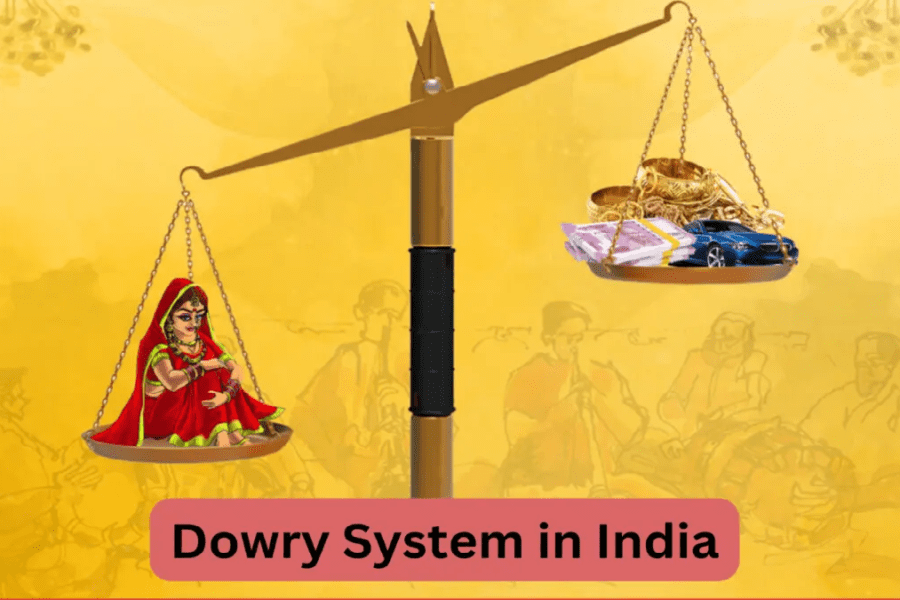Dowry is a cultural custom that involves the transfer of money, assets, or valuable items from the bride’s relatives to the groom or his relatives during the marriage ceremony. Though originating from age-old practices intended to aid newly married couples, dowry has transformed into a significantly troubling custom in numerous regions, especially in South Asia. It frequently imposes significant financial stress on the bride’s family and can result in severe outcomes like domestic violence, harassment, and even deaths related to dowries. Although legally banned, dowry continues to be a significant issue, highlighting wider problems related to gender inequality and social norms.
Dowry death, as per Indian law, refers to the demise of a woman due to burns, physical harm, or under unusual conditions, occurring within seven years of marriage, where evidence indicates that she faced cruelty or harassment from her husband or his relatives related to dowry demands. This is specified in Section 304B of the Indian Penal Code. In this context, the term “dowry” carries the same definition as outlined in the Dowry Prohibition Act of 1961.
SOCIAL CONTEXT: A BRIDE’S BURDEN
In numerous cultures, particularly in South Asia, the dowry practice has imposed an unjust and heavy load on brides and their families. Rather than being regarded as an equal contributor in marriage, the bride is frequently viewed as a financial burden, with her value determined by the dowry she offers. This expectation imposes financial stress on her family while also exposing the bride to emotional and psychological stress. In certain situations, women encounter abuse, harassment, or even violence if the dowry is deemed inadequate. The obligation to meet dowry demands strengthens gender inequality and diminishes the dignity and independence of women, perpetuating a cycle of discrimination that spans generations.
LEGAL PROVISIONS AGAINST DOWRY DEATH
- Section 304 IPC, 1860 and Section 80 BNS, 2023
Death caused: By burns; By bodily injury, or occurs otherwise than under normal circumstances
Time of death: Death occurred within seven years of marriage.
It should be shown: Soon before her death. She was subjected to cruelty or harassment by her husband or any relative of her husband. For or in connection with any demand for dowry
Such death: shall be deemed to have been caused by such husband or relative of her husband.
- Section 113B IEA, 1872 and Section 118 BSA, 2023
This provides for presumption in cases of dowry death.
The provision comes into play: When the question is whether a person has committed dowry death of a woman.
The following should be shown to raise the presumption: It is shown that soon before her death, such a woman has been subjected to cruelty or harassment for or in connection with a demand for dowry by that person.
The following presumption is raised: The Court shall presume that such a person has caused dowry death.
REASONS WHY DOWRY IS A PROBLEM IN INDIA
- Abuse and mistreatment: The demand for dowry frequently results in the abuse and mistreatment of the bride and her family. The groom’s relatives might request excessive sums of money or items, and if these requests are not fulfilled, the bride could face physical or emotional mistreatment.
- Social and economic strain: The dowry system imposes a considerable social and economic strain on the bride’s family. Numerous families must either borrow money or sell their possessions to fulfill dowry requirements, resulting in economic strain and anxiety.
- Gender discrimination: The dowry system continues to promote discrimination against women, bolstering the idea that they are a liability to their families. The practice further weakens women’s independence and decision-making, as they are frequently compelled to marry into households that expect dowries.
- Violation of human rights: The dowry practice violates several human rights, such as the right to equality, the right to life, and the right to be free from exploitation.
SOLUTIONS
- Inform Individuals: It’s essential to make people aware that dowry is intolerable and constitutes a serious offense. We must teach boys and girls, men and women, about the risks associated with dowry.
- Implement Regulations: We must ensure that the regulations concerning dowry are applied. This signifies that law enforcement and judicial systems must act against individuals who request or provide dowry.
- Assist Victims: It is essential to assist women who suffer from dowry-related harassment or abuse. This entails offering them housing, support, and legal assistance. • Alter Societal Norms: It’s essential to shift societal perceptions regarding dowry. It must become unacceptable for individuals to ask for or provide dowry.
- Engage Men: It’s essential to engage men in the battle against dowry. Men must raise their voices against dowry and back women suffering from dowry harassment or violence.
LANDMARK JUDGMENTS
- Satbir Singh v. State of Haryana (2021)
In this landmark judgment, the Supreme Court of India upheld the conviction of the accused under Section 304B of the IPC. The Court emphasised the need for a strict interpretation of dowry death provisions to curb the menace effectively.
- Vijay Kumar v. State of Rajasthan (2014)
The Supreme Court, in this case, highlighted the importance of corroborative evidence in dowry death cases. The Court stressed that mere allegations are not sufficient, and there must be convincing evidence to establish a direct link between the death and dowry demands.
CONTRIBUTED BY- SHIKHA

